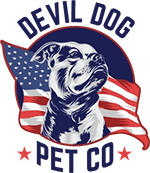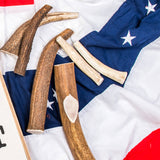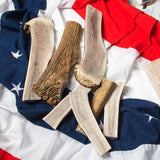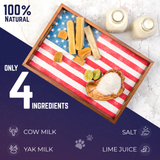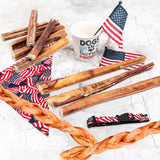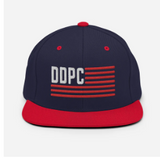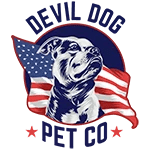Key Takeaways
- Antler chews are commonly suggested as a solution for teething puppies.
- Antler chews are generally not safe for puppies due to risks to their developing teeth and jaws.
- Most veterinarians and experienced dog owners advise against giving antlers to puppies.
- The idea of safe antler chews for puppies is misleading and should be approached with caution.
Table of Contents
- Are Antler Chews Safe for Puppies?
- Puppy Teething 101: What's Happening in That Mouth?
- Understanding Antler Chews: Types, Sources, and What Makes Them Different
- Risks of Antler Chews for Puppies: Dental, GI, and Choking Hazards
- Are There Any Safe Antler Chews for Puppies? Product Design and Breed Considerations
- How to Safely Introduce Antler Chews (or Better Alternatives) to Your Puppy
- Antler Chews vs. Puppy-Safe Alternatives: The Complete Breakdown
- Real Benefits of Chewing for Puppies: Separating Science from Marketing
- Common Chew Problems and Battle-Tested Solutions
- How to Safely Introduce Chews to Your Puppy
- The Complete Puppy Chew Comparison: Finding the Right Alternative
- The Science Behind Puppy Chewing: Nutritional and Behavioral Benefits
- Troubleshooting Common Puppy Chew Problems
- Extreme Dog Leadership: Your Chew Selection Mindset
The Real Story on Safe Antler Chews for Puppies
Your 4-month-old pup is chewing through everything, shoes, baseboards, your sanity. Someone mentions antler chews as the "ultimate solution." Before you hand over that rock-hard elk antler, here's the unfiltered truth: safe antler chews for puppies is almost an oxymoron. Most veterinarians and experienced dog owners know that antlers pose serious risks to developing teeth and jaws.
As a Marine veteran who's seen what happens when the wrong gear meets the wrong mission, I'm here to give you the straight facts on puppy chewing, antler safety, and better alternatives that won't land you in the emergency vet clinic.
For teething puppies that need a safer outlet, our 6" Ultra Thick Bully Sticks offer a digestible, long-lasting chew that satisfies their urge to gnaw without the dental risks of antlers.
Download the FREE 10-Step Dog Prep Guide
Are Antler Chews Safe for Puppies?
The short answer is no, and here's why that matters. Puppy teeth don't fully develop until around 5-6 months, and their jaw muscles lack the strength to handle antler density safely. When a 3-month-old puppy tries to power through a whole elk antler, physics wins every time.
Over 90% of veterinary dentists advise against antlers for puppies under 6 months. The risk isn't just theoretical, slab fractures of developing molars can require surgical extraction and cost upwards of $2,000 per tooth. One of our customers, Becky, learned this the hard way when her 4-month-old rescue cracked a premolar on a deer antler. The bleeding, the emergency vet visit, and the month of soft food could have been avoided.
Even after 6 months, safe antler chews for puppies require careful selection. Only oversized split antlers with exposed marrow should be considered, and even then, supervision is non-negotiable. The window between "too young" and "adult-ready" is narrow, most experienced owners skip antlers entirely until their dog hits 12-18 months.
Puppy Teething 101: What's Happening in That Mouth?

Understanding teething stages prevents costly mistakes. Puppies get their first baby teeth around 3-4 weeks, but the real chaos starts at 12-16 weeks when adult teeth push through. Peak teething hits between 4-6 months, exactly when desperate owners reach for the hardest chew they can find.
During teething, puppies chew to relieve gum pressure and explore their world. You'll see increased drooling, occasional blood spots on toys, and a preference for cold, firm surfaces. This is normal, but it doesn't mean they need industrial-strength antlers. Their jaws are doing important developmental work that hard chews can disrupt.
The key difference: teething chewing is about relief and exploration, while destructive chewing signals boredom or anxiety. Teething pups gnaw methodically and often favor one side of their mouth. Destructive chewers attack with intensity and switch targets rapidly. Recognizing this difference helps you choose appropriate outlets, and explains why what age can puppies chew antlers is the wrong question. The right question is whether they should at all.
Understanding Antler Chews: Types, Sources, and What Makes Them Different
Not all antlers are created equal, and the differences matter for safety. Deer antlers are the hardest, often harder than dog teeth, while elk antlers offer slightly more give. Moose antlers sit somewhere between but are rarely available in appropriate puppy sizes. The density comes from the mineral matrix: calcium phosphate that makes antlers incredibly durable and potentially dangerous.
Whole antlers maintain their full structural integrity, making them the longest-lasting but hardest option. Split antlers expose the softer marrow core, providing flavor and reducing the force needed to make progress. For any puppy consideration, splits are the only remotely safe option, and even then, only for older puppies with fully erupted adult teeth.
At Devil Dog Pet Co., we source exclusively from wild Rocky Mountain elk sheds collected by licensed hunters each spring. These naturally dropped antlers undergo rigorous inspection, no bleaching, no artificial hardening, no shortcuts. But even our premium splits come with clear age recommendations because quality doesn't eliminate physics. The pros and cons of antlers for dogs shift dramatically based on age, and puppies fall squarely in the "cons" category.
Risks of Antler Chews for Puppies: Dental, GI, and Choking Hazards
Puppy teeth fracture differently than adult teeth, and more catastrophically. The developing root structure means a cracked puppy molar often requires complete extraction rather than repair. Veterinary dentists report seeing more antler-related fractures in dogs under 12 months than any other age group, with repair costs averaging $1,500-$3,000 per incident.
Gastrointestinal obstruction presents another serious risk. Puppies tend to swallow larger pieces than adult dogs, and their smaller digestive tracts can't accommodate antler chunks that would pass safely in a mature dog. Emergency surgery to remove obstructions runs $3,000-$7,000 and requires days of intensive care.
Three red flags demand immediate veterinary attention: bleeding from the mouth during or after chewing, visible cracks or chips in teeth, and any missing pieces from the antler that can't be accounted for. Real supervision means staying within arm's reach, not scrolling your phone from across the room. When our dog Dexter showed interest in antlers at 5 months, we waited until 8 months and started with oversized splits under direct supervision, even then, we retired them after two sessions when we noticed excessive wear on his molars.
Are There Any Safe Antler Chews for Puppies? Product Design and Breed Considerations

"Puppy antlers" are largely a marketing myth. No amount of product engineering can make antler density appropriate for developing teeth. The best-case scenario involves waiting until 6+ months, choosing only split antlers, and sizing up dramatically, but even this carries significant risk that most veterinarians consider unacceptable.
If you're determined to try antlers with an older puppy, apply the three-part safety test: Can you make an indentation with your thumbnail? (If not, too hard.) Is it longer than your puppy's entire muzzle? (Can't be swallowed whole.) Does it pass the "whole mouth test"? (Won't fit entirely between back molars.) Even then, start with 5-minute supervised sessions and watch for any signs of discomfort or aggression toward the chew.
How to Safely Introduce Antler Chews (or Better Alternatives) to Your Puppy
If you've decided your older puppy (6+ months with full adult molars) might handle a split antler, the introduction process demands military precision. Hold one end of the antler while your pup investigates the other, this prevents gulping and lets you control the session. Rub a tiny amount of low-sodium bone broth on the marrow to boost initial interest, but skip peanut butter if your pup has never had it before.
Limit first sessions to 5-10 minutes max, then remove the antler regardless of your pup's protests. Store it in a dry place and bring it back tomorrow. This "scarcity training" keeps the chew valuable while preventing overuse injuries. Watch for excessive drooling, pawing at the mouth, or any pink spots on the antler, all signs to stop immediately.
The smarter move? Start with an oversized yak chew or thick bully stick instead. These alternatives offer the same jaw exercise and mental stimulation without the tooth-cracking risk. Our dog Dexter graduated from yak chews to split antlers at 8 months, but only after proving he could handle softer chews responsibly. Train the "drop it" command before introducing any long-lasting chew, you'll need that reliability when it's time to swap out a worn-down piece.
Antler Chews vs. Puppy-Safe Alternatives: The Complete Breakdown
Smart puppy owners stock multiple chew types and rotate based on energy level, teething intensity, and training goals. While safe antler chews for puppies remain controversial among veterinarians, proven alternatives deliver similar benefits with dramatically lower risk profiles.
| Chew Type | Hardness Level | Digestibility | Puppy Safety | Longevity | Mess Factor |
|---|---|---|---|---|---|
| Whole Elk Antlers | Very Hard | Minimal (dust only) | High Risk | Weeks to Months | Very Low |
| Split Elk Antlers | Hard | Low (marrow) | Moderate Risk | 1-3 Weeks | Low |
| Yak Cheese Chews | Medium-Hard | Fully Digestible | Low Risk | 1-2 Weeks | Very Low |
| Bully Sticks | Medium | Fully Digestible | Very Low Risk | 20-60 Minutes | Low Odor |
| Nylon Chews | Hard | Not Digestible | Moderate Risk | Months | None |
Yak chews emerge as the sweet spot for most teething puppies, hard enough to satisfy serious chewers, soft enough to avoid dental trauma, and fully digestible if small pieces break off. Devil Dog Pet Co.'s Himalayan yak chews undergo traditional smoking and drying processes that create the ideal texture: firm outer shell with accessible inner layers that reward persistent gnawing.
For power-chewing puppies, start with an oversized yak chew and graduate to split antlers only after 8 months of age and demonstrated chew discipline. The key is matching chew hardness to jaw development, not just calendar age or breed stereotypes.
Real Benefits of Chewing for Puppies: Separating Science from Marketing

Proper chewing delivers measurable benefits for developing puppies, but antler manufacturers often oversell the dental health angle. The truth: any appropriately-sized chew that requires sustained gnawing will help scrape soft plaque and exercise jaw muscles. Antlers don't possess magical plaque-fighting properties that softer alternatives lack.
The behavioral benefits prove more significant. Sustained chewing releases endorphins that calm anxious puppies and provides crucial mental stimulation during those long afternoon energy crashes. A 15-minute chew session often replaces 30 minutes of destructive behavior, your baseboards will thank you. However, chews can't substitute for proper training, socialization, or adequate physical exercise.
Nutritionally, antler chews contribute minimal calories (mostly mineral dust) while yak chews and bully sticks add protein and fat that must be calculated into daily intake. For a 20-pound puppy, one standard bully stick represents roughly 10% of daily calories, not insignificant for growing dogs. The mineral content in antler dust provides trace amounts of calcium and phosphorus, but a quality puppy food already delivers these nutrients in proper ratios.
Key Insight: Chews excel at behavioral management and jaw exercise, but they're supplements to, not replacements for, proper nutrition, training, and veterinary dental care.
Common Chew Problems and Battle-Tested Solutions
Even with careful selection and supervision, chew-related issues crop up. Bleeding gums signal either too-hard materials or overly aggressive chewing style, remove the chew immediately and switch to something softer. Pink-tinged saliva during teething is normal; bright red blood is not. When our dog Dexter showed gum sensitivity at 5 months, we rotated him off antlers for two weeks and returned with split pieces only.
Stomach upset from rich marrow or swallowed antler dust usually resolves within 24 hours with bland food and fresh water. However, if your puppy shows signs of intestinal blockage, vomiting, lethargy, straining to defecate, contact your veterinarian immediately. Prevention beats treatment: always size up rather than down, and retire chews before they become swallowable.
For puppies who lose interest quickly, try the "flavoring trick", rub a dab of unsalted bone broth or peanut butter on the surface to reactivate scent. Rotate between different chew types weekly to maintain novelty. Never force a chew; some pups need time to develop their gnawing confidence.
Training the "drop" command before introducing any chew prevents resource guarding and makes emergency removal seamless. Hold a high-value treat near your pup's nose, say "drop," and reward the moment they release. Practice with toys first, then graduate to actual chews.
Devil Dog Safety Protocol: Every chew session starts with a 5-minute timer. Stay within arm's reach, watch jaw positioning, and end on a positive note. Your pup should associate chewing with calm leadership, not anxiety.
The Complete Puppy Chew Comparison: Finding the Right Alternative

Since safe antler chews for puppies remain problematic until adult teeth fully develop, smart owners build a rotation of gentler alternatives. Each chew type serves different developmental needs and chewing styles.
| Chew Type | Hardness Level | Digestibility | Teething Safety | Duration | Best For |
|---|---|---|---|---|---|
| Yak Chews | Medium-Hard | 100% | High | 1-2 weeks | Moderate chewers, 12+ weeks |
| Bully Sticks | Medium | 100% | High | 20-60 minutes | All puppies, training rewards |
| Split Antlers | Hard | Minimal | Moderate | 2-4 weeks | 6+ months, supervised only |
| Rope Toys | Soft | No | High | Varies | Gentle teethers, interactive play |
| Frozen Kongs | Medium | Varies | High | 30-45 minutes | Crate training, mental stimulation |
Devil Dog Pet Co. yak chews lead this comparison because they're fully digestible, last significantly longer than bully sticks, and contain beneficial minerals without the tooth-fracture risk of whole antlers. Our Himalayan yak chews are crafted from traditional recipes, smoke-dried for weeks, and contain zero artificial preservatives.
For power-chewing puppies who destroy softer options, our split antlers offer a compromise, but only after 6 months and with constant supervision. The exposed marrow provides immediate flavor reward while the outer wall delivers extended gnawing satisfaction.
For more details on choosing the right size and type of chew for your puppy, see how to choose safe dog chews that are the right size for your dog.
The Science Behind Puppy Chewing: Nutritional and Behavioral Benefits
Chewing serves critical developmental functions beyond simple entertainment. During the 3-7 month teething window, controlled chewing strengthens jaw muscles, promotes proper tooth alignment, and provides natural pain relief through endorphin release.
Nutritionally, quality chews contribute trace minerals and protein, though they should never exceed 10% of daily calories. Devil Dog yak chews provide calcium and phosphorus in ratios that support growing bones, while our bully sticks deliver single-ingredient protein without fillers or by-products.
Behaviorally, appropriate chewing prevents destructive habits from forming. Puppies denied suitable outlets often target furniture, shoes, or dangerous objects. A 15-minute supervised chew session can provide 2-3 hours of mental satisfaction, equivalent to a long training session.
The key lies in timing and selection. Offer chews during natural energy peaks (morning, post-meal, before crate time) rather than as corrections for bad behavior. This builds positive associations and teaches your pup that chewing has proper times and places.
For a detailed look at which antler chews are best suited for puppies, check out small split elk antler chews for puppies.
Troubleshooting Common Puppy Chew Problems
Even with careful selection, issues arise. Recognizing early warning signs prevents minor problems from becoming veterinary emergencies.
Excessive drooling or pawing at mouth: Remove the chew immediately and inspect for blood, swelling, or foreign objects. Teething discomfort is normal; injury symptoms require immediate vet attention.
Vomiting or lethargy after chewing: Usually indicates too much rich protein too quickly. Withhold food for 12 hours, offer water, and contact your vet if symptoms persist. Future sessions should be shorter with longer intervals between chews.
Resource guarding around chews: Never attempt to physically remove a chew from a guarding puppy. Instead, create distance, call your pup away with a higher-value treat, and work on "drop" training during non-chew times. Some puppies need individual chew time away from other pets.
Complete disinterest in any chew: Some pups are naturally less motivated by chewing. Try different textures, temperatures (frozen vs. room temperature), and flavoring techniques. If disinterest persists, focus on other enrichment activities like puzzle toys or training games.
For more information on pet treat safety, refer to this FDA resource on pet treats and chews.
Extreme Dog Leadership: Your Chew Selection Mindset

Choosing safe antler chews for puppies, or any chew, reflects your leadership philosophy. At Devil Dog Pet Co., we believe every decision starts with owner accountability, not marketing promises or convenience.
Extreme Dog Leadership means researching before purchasing, sizing up rather than down, and accepting that supervision isn't optional. It means understanding that your 3-month-old's safety matters more than the longest-lasting chew on the market.
This mindset extends beyond chews to every aspect of dog ownership. The same discipline that keeps you present during chew sessions builds the foundation for reliable recall, loose-leash walking, and lifelong behavioral stability.
For a scientific perspective on antler safety, see this peer-reviewed article on antlers and pet safety.
John's Leadership Principle: "Every chew session is a training opportunity. Your pup learns from your presence, your timing, and your standards. Lead with intention, and you'll raise a confident, disciplined teammate for life."
Download the FREE 10-Step Dog Prep Guide
Frequently Asked Questions
Why are antler chews considered unsafe for puppies, especially under 6 months old?
Puppy teeth and jaws are still developing and lack the strength to safely handle the extreme hardness of antler chews. Chewing on dense antlers can cause fractures or damage to fragile adult teeth that haven’t fully erupted yet, making antlers unsafe for puppies under 6 months.
What are the potential dental and health risks associated with giving antler chews to teething puppies?
Antler chews can cause cracked or broken teeth, oral injuries, and choking hazards if pieces break off. Additionally, swallowing large shards or marrow too quickly can lead to digestive upset or blockages, posing serious health risks to teething puppies.
Are there any safe alternatives to antler chews for puppies that satisfy their chewing needs?
Yes. Digestible options like Devil Dog Pet Co.'s 6" Ultra Thick Bully Sticks provide a safer, long-lasting chew that satisfies teething urges without risking dental damage. Soft, oversized split antlers or specially designed puppy chews are also better choices under supervision.
At what age, if any, can a dog safely start chewing on antlers, and what precautions should be taken?
Most dogs can safely start chewing on antlers once their adult molars have fully erupted, typically around 5 to 6 months old. Begin with split antlers to expose marrow, limit chew sessions to 10–15 minutes, choose the right size, and always supervise to prevent dental injury or choking.
